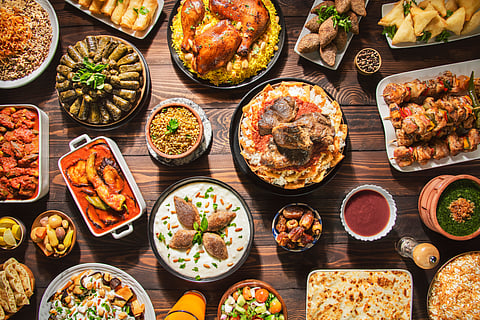
- Destinations
- Experiences
- Stay
- What's new
- Celebrating People
- Responsible Tourism
- CampaignsCampaigns
- SubscribeSubscribe
- Buy Now

From the iconic Pyramids of Giza to its ancient temples and tombs, Egypt offers a glimpse into one of the oldest civilisations in the world. But have you considered that its cuisine could be one of its top attractions too? Using poultry, legumes, vegetables and fruit from the Nile Valley, the food is surprisingly suitable for vegetarians, although meat is commonly cooked as well. Food in Alexandria and the coast of Egypt tends to use a great deal of fish and other seafood but, for the most part, Egyptian cuisine is based on foods that grow out of the ground.
Ful medames is a stew of cooked fava beans served with olive oil and cumin, optionally topped with chopped parsley, garlic, onion, lemon juice and chilli pepper. It is traditionally made in and served out of a large metal jug. It is a popular breakfast dish in Egypt and is a staple meal in Cairo and Giza. Ful medames are often served as part of a larger mezze throughout the day with baba ganoush, hummus and labne. It is said to have been invented over 2,500 years ago.
Most people know that falafel is made with chickpeas but Egyptian falafel is traditionally made with fava beans. The resulting dish is called ta'ameya. The fava beans are soaked overnight and cooked with coriander seeds, spices and sesame for an extra crunch. Although they are eaten year-round and are a common street food in Egypt, ta'ameya fritters are especially popular during the holy month of Ramadan. You can eat it stuffed in pita with salad and tahini.
Ever thought of eating a pigeon? Hamam mahshi involves selecting the plumpest, six-week-old squabs, stuffing them with rice or freekeh, onions, giblets, spices and nuts, then roasting it over charcoal or grilling it whole. The dish is usually served on special occasions but often appears on many restaurant menus. When cooked well, it is hearty, complex and delicious.
Mulukhiyah is the name of leafy greens—known in English as jute leaves—which are blitzed up and served as a thick stew, usually with a side of rice. The vegetable is bitter and when boiled, the resulting liquid is a thick, gluey broth; it is often described as "slimy", rather like cooked okra. Cooks in Alexandria often opt to use shrimp in the soup, while Port Said is famous for using fish. Many Egyptians consider mulukhiyah to be the national dish of Egypt, along with ful medames and koshary.
Widely considered Egypt's national dish, koshary is made of rice, lentils (black or brown), chickpeas and pasta cooked individually, then tossed together and topped with cumin-scented tomato sauce and crunchy fried onions. Condiments of garlicky vinegar and a peppery hot sauce called shatta are added to boost the flavour profile. Heavily laden with carbs and calories, a plate of koshary fills up even the hungriest of stomachs for just a few Egyptian pounds. As traditionally prepared koshary does not contain any animal products, it can be considered vegan, as long as all frying uses vegetable oil.
Hawawshi is a pita stuffed with minced meat and spiced with onions, pepper, parsley and occasionally chillies. The major variants of hawawshi are "baladi” and Alexandrian. In most of Egypt, it is made by filling the flat Egyptian bread with the meat mix and then baking it in the oven. In Alexandria, the ingredients are placed between two circular layers of dough and then baked in an oven. Alexandrian hawawshi also has different spices and seasonings. Whether prepared at home or enjoyed in various Egyptian food establishments, hawawshi is usually served alongside fresh vegetables, salads and various dips.
This is a flaky layered pastry consisting of many thin layers of dough and ghee and an optional filling. The fillings can be both sweet and savoury. Sweet fillings can include cheese, coconut, mehalabiya, malban, Nutella or chocolate, while savoury fillings can be anything from ground beef to sausage or cheese. Plain feteer meshaltet is usually soaked in honey and spread with jam, cheese or served with olives. Because of its versatility, feteer meshaltet is often referred to as an Egyptian pizza. The dish dates back to the time of the pharaohs when it was often used in temples as an offering to gods. Nowadays, it is traditionally prepared and consumed for religious holidays, weddings and similar social events.
